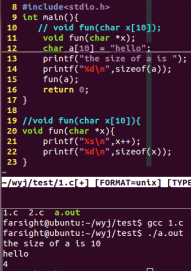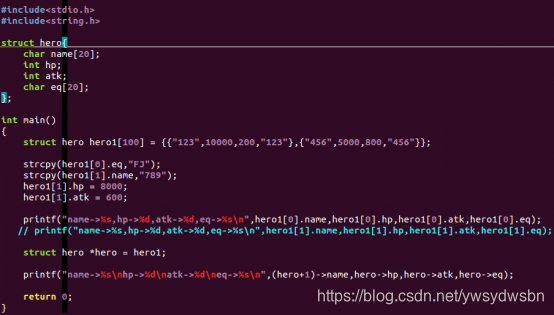接到以上文章:
Linux学习笔记(一)
复习
一维数组和指针:int a[10];int *p=a;

二维数组和指针:int *q = &z[0[0]

指针数组:int *p[n];===存多个地址的数组
数组指针:int (*p)[n];===指向整个数组的指针
函数指针数组:int (*p[n])();===存函数地址的数组

函数
函数:解决问题的方法
声明:
函数类型 函数名(形式参数。。。){
具体功能实现;
}
函数传参:值传递、地址传递、全局变量(函数传参的过程是一个值拷贝的过程)
数组作为参数传递:以指针的方式传递
结构体
结构体: 程序员自己定义的数据类型
结构体定义:
1、只有结构体定义
struct stuff{
char job[20];
int age;
float height;
};
2、附加该结构体类型的“结构体变量”的初始化的结构体定义
struct stuff{
char job[20];
int age;
float height;
};
struct stuff Huqinwei;
Eg:
struct student{
int weight;
int height;
char name[10];
};
stuct student stu = {40,175,”wyj”};
更改数值用strcpy
用一条语句声明结构和该结构的实例时,可以省略标记符名字
结构体数组:
struct student stu[50] = {{30,176,”euwhj”},{46,185,”hjdu”}};
strcpy(stu[0].name,”wudh”);//字符型用strcpy更改
stu[0].weight = 40;//整型可直接赋值
结构体指针:
struct student *student = stu;
printf(“weight:%d\nheight:%d\nname:%s\n”,student->weight,student->height,student->name);
结构体指针用指向取值(eg:student->weight)

文件I/O
Man手册查看函数的声明(q退出)
i.open(const char *pathname(被打开的文件名),int flags,mode t mode(打开文件的权限) );
看返回值:若返回值小于0,则打开失败;若返回值大于0,则打开成功。
ii.close(int fildes);// fildes(open的返回值)
看返回值:若返回值小于0,则打开失败;若返回值大于0,则打开成功。
iii.read(int fd,char *buf,size_t count);
调用成功返回读取的字节数
iv.write(int fd,const *buf,size_t count);//const:把变量常量化
v.lseek(int fd,off_t offset,int whence);
fd:文件描述符
offset:偏移量,每一读写操作所需要的距离
SEEK_SET:当前位置为文件的开头,新位置为偏移量的大小
SEET_END:当前位置为文件的结尾,新位置为文件的大小加上偏移量的大小
SEET_CUR:当前位置为文件指针的位置,新位置为当前位置加上偏移量

线程
线程: 程序的一次执行过程
pthread_create:创造线程

编译时要手动给一个链接:gcc 文件名 -lpthread

Pthread_join:阻塞线程

pthread_join()函数会一直阻塞调用线程,直到指定的线程tid终止。当pthread_join()返回之后,应用程序可回收与已终止线程关联的任何数据存储空间,(另外也可设置线程attr属性,当线程结束时直接回收资源)如果没有必要等待特定的线程。
代码演示
读写图片:
#include<stdio.h>
#include<stdlib.h>
#include<sys/types.h>
#include<sys/stat.h>
#include<fcntl.h>
#include<unistd.h>
int main(){
int fp;
fp = open("1.jpg",O_RDWR);
if(fp < 0){
printf("open error\n");
exit(EXIT_FAILURE);
}
printf("open success\n");
int fd = open("2.jpg",O_RDWR);
if(fp < 0){
printf("open error\n");
exit(EXIT_FAILURE);
}
printf("open success\n");
while(1){
char buf[64] = {0};
int ret = read(fp,buf,64);
if(ret < 0){
printf("raed errorr\n");
return -1;
}
if(ret == 0){
break;
}
ret = write(fd,buf,64);
}
close(fp);
close(fd);
return 0;
}
查看图片:eog 2.jpg
加密和解密:
#include <stdio.h>
#include <sys/types.h>
#include<stdio.h>
#include<stdlib.h>
#include<sys/types.h>
#include<sys/stat.h>
#include<fcntl.h>
#include<unistd.h>
int jm(){
char path[30] = {0};
gets(path);
int f = open(path,O_RDWR);
if(f < 0){
perror("open");
return -1;
}
int i;
printf("1.加密 2.解密 :");
scanf("%d",&i);
char head;
read(f,&head,1);
if(i == 1){
head = head + 1;
}
if(i == 2){
head = head - 1;
}
lseek(f,0,SEEK_SET);
write(f,&head,1);
close(f);
return 0;
}
int main(){
int fp;
fp = open("1.jpg",O_RDWR);
if(fp < 0){
printf("open error\n");
exit(EXIT_FAILURE);
}
printf("open success\n");
int fd = open("2.jpg",O_RDWR);
if(fp < 0){
printf("open error\n");
exit(EXIT_FAILURE);
}
printf("open success\n");
while(1){
char buf[64] = {0};
int ret = read(fp,buf,64);
if(ret < 0){
printf("raed errorr\n");
return -1;
}
if(ret == 0){
break;
}
ret = write(fd,buf,64);
}
jm();
close(fp);
close(fd);
return 0;
}
收获及感悟
今天最先复习了昨天主要学习的内容,之后主要学习了结构体、文件I/O和线程三大类,在巩固以前学过的知识的同时也学习了很多新的东西。文件I/O和线程之前都没怎么接触过,通过今天的学习了解了这两大功能,也感受到了这两类的强大作用,今天算是收获良多,很期待明天的学习!!!
待续。。。。。将持续更新,感谢大家关注点赞
